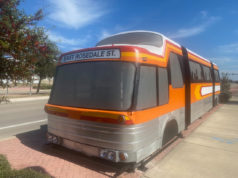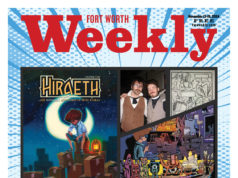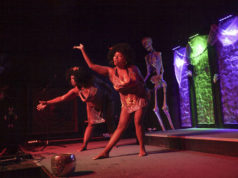He wouldn’t have ditched the event, but there’s a part of him that may have wanted to.
Waiting for Christopher Blay at the Meadows Museum on the campus of Southern Methodist University last week were dozens of North Texas art-world movers and shakers, there to honor him as the 18th winner of the Moss/Chumley Award. Given by a select committee to a North Texas artist who’s as good at art as he or she is at advocating on its behalf, the award also comes with a $1,500 check and, apparently, a lot to live up to –– past recipients include Frances Bagley, Noah Simblist, and last year’s winner, Stephen Lapthisophon.
Blay, though, has a love-hate relationship with the official (and often officious) art world. No one is saying that he’s completely averse to the dreaded Establishment –– the Texas Christian University grad has been the curator of Art Corridor II at Tarrant County College’s Southeast Campus for the past few years. But Blay also is the same guy who stood in front of the Modern Art Museum of Fort Worth for six hours straight (captured all on video) as part of an elaborate institutional critique. And if you know him, you know that he prefers house parties over formal occasions. The Meadows might as well be Downton freaking Abbey.
Alas, the avowed nonconformist got all dressed up and went.
So, Chris, what’s it like now being even more a part of The Establishment?
“Ask me again when I can fill my tank beyond half!” he said via e-mail the other day.
Since he first began exhibiting in the early 2000s, Blay has gone from complete outsider to borderline insider without –– and here’s the amazing part –– altering his vision. He’s still inspired by photography, art about art, and history, and though he’s partial to installations, he still addresses his inspirations via multiple media. For one of his first solo exhibitions, in an abandoned Southside warehouse, Blay hung dozens of empty white-ish bottles at varying distances from the rafters. For another, Microaudiotellarevolution, at Gallery 414, he offered a smorgasbord of heady imagery, including an old-fashioned slideshow of himself dressed as Liberian dictator Charles G. Taylor, several microfilm machines repurposed as portholes through which viewers could spy semi-abstracted images of prisoners of war and soldiers, and a few dozen black audio cassette recorders hanging in rows from a wall and playing back eight hours of transcripts read aloud by Blay from Taylor’s Hague trial for war crimes during the 1980 coup. The exhibit, as I wrote at the time (“The Revolution, Televised,” Feb. 18, 2009), was “a stark surreality where Death’s scythe is a reporter’s microphone, his hood a shako, and where soldiers die a million silent deaths and soundbites annihilate logic.”
Over the years, Blay, in staunch objection to any local or international trends, continued exploring his particular take on contemporary art, an intoxicating blend of intellectualism and intentionally crude (or crude-seeming) execution. In 2011 at Ro2 Art in Dallas, he produced Art Depreciation: Art Before and After Culture, a collection of mixed-media mashups of supposedly high- and middlebrow phenomena, the collision manifested most succinctly by such pieces as “Samuel L. Jackson Pollock” and “Steely Dan Flavin.” He also connected photography with time travel (years before Don Draper ever thought to). The chief visual components of Blay’s Time Machine Beta at Conduit Gallery in Dallas were salvaged vintage hair-drying stations.
“One of the strongest criticisms I’ve gotten about my work: It’s not just one thing,” he said over coffee recently. “ ‘Why don’t you have one solid body of work that you can sort of draw a thread through?’ That’s just not the way I think, and that’s not the way I work.”
In between transforming detritus and references into art, Blay took his message to the streets. In the early ’00s, he created the annual Thrift Art Gallery Show and Auction, in which he auctions off naïve art that he’s gathered mostly from secondhand stores (with bids beginning at 50 cents), and Frank Artsmarter, a character who looks and sounds an awful lot like Blay and who pulls pranks on and performs skits with North Texas art-world personalities. It was Artsmarter, not Blay, who, um, stood for art in front of the Modern.
At TCU, Blay established the f.8 photography collective and in 2011 co-founded the upstart HOMECOMING! Committee.
“A really awesome artist once told me there has to be integrity and honesty in what you’re doing,” Blay said, “so I talk about things that I think about, not things that I want to respond to to get into a gallery, because I made a conscious decision a long time ago that that shit doesn’t work anyway. The more you try to cater to what someone wants, the less appealing your art is to 10 other people who might be interested in what you’re doing.”
Stepping outside of his studio and into the wider world also involves community activism through art. For VELVEASL!, a 2013 fund-raiser for the Emergency Artists Support League, Blay commissioned some of the best known painters in North Texas to work on velvet –– he auctioned off all 22 paintings at a one-night-only event at William Campbell Contemporary Art in May, raising about $7,000 for EASL.
In 2006, Blay also began an oral history project. Supported by a grant from the Arts Council Northeast, he has recorded people from Haltom City and Keller reminiscing about their neighborhoods on tape. “My work just happens to overlap with connections in the community,” he said.
Blay’s current large-scale project is a kind of extension of his work in the northeast. Along with one team of artists and nine other artists of various disciplines, including Fort Worth poet Tammy Gomez, Blay was recently chosen by bcWORKSHOP, a Dallas community design center, to participate in Activating Vacancy. As part of the artists’ National Endowment for the Arts-funded effort to “investigate, strengthen, and share” the history of Dallas’ historic 10th Street district, bc chiefs say, Blay is making an ark. “The [Greater El Bethel Baptist Church] borders a street called Noah Street,” Blay recalled. “I was like, ‘Noah, ark –– bam! –– done.’ ”
About 12 feet high, 25 feet long, and 8 feet wide, the vessel will be made of salvaged doors and windows. Inside will be a finished-out shipping container that will house panels or artworks created by residents. “The Ark on Noah Street” will drop anchor in the church’s parking lot and be visible from several directions. The residents, Blay said, “will bring their panels into the ark, using all the metaphors that I can, two by two. One part of the panel is their past. One is their present.”
The processional event will include a barbecue. The piece will be up for 40 days and 40 nights starting in late February.
“The thing is,” Blay said, “the ark sort of contains the community. … It’s like a collaboration that combines sculpture, social interaction, collage, sculpture, all those things, and it can’t be anything other than what it is.”
Blay is only the second Fort Worth artist to win the Moss/Chumley, the other being multimedia artist Janet Tyson, who has since moved away. As was true with Tyson when she lived here, Blay does most of his work in Big D. In addition to the ark, he also will be working as an instructor for various art camps at the Nasher Sculpture Center.
“Dude,” he said somewhat exasperatedly. “You have to go where the opportunities are. … I love [Fort Worth]. You know that. If I had the same opportunities here and had to pick, I wouldn’t drive 45 minutes away, but … props to Dallas.”
Over the past year or so, both the Nasher and Dallas Museum of Art offered “unprecedented” access, in Blay’s opinion, to North Texas artists, including HOMECOMING! “Hopefully, that happens in Fort Worth,” he said.
Blay applied for Moss/Chumley, he said, “because it was a form of peer review from a panel of jurors who represent, to a large degree, the important institutions of the contemporary visual arts in Texas. It was a good review.”
The award, he continued, “recognizes that I’m a part of a thriving art community with a lot of artists who continue to do what they do regardless of recognition. What I hope it does is integrate me more in my community, because we all benefit when any of us get recognized.”
Blay still feels like an outsider, though. “It’s difficult to completely exist in the world of art, because it’s … ever-changing and ever-evolving,” he said. “To be comfortable there, to have a full seat at the table, is by definition an uncomfortable place. I feel like I have to keep getting up, leaving the room, and coming back. It’s like I can’t just hold my place at the table.”













I participated in Blay’s project in Haltom City and found him and his work very interesting. Congrats on the award, sir!